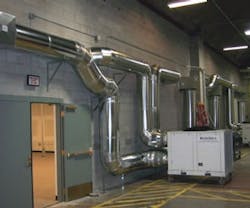Using Portable Cooling for Emergency, Temporary and Long-Term Use
As temperatures start to sizzle, portable air conditioners are in wide demand for emergency service. But contrary to common belief, portable air conditioning units are not just for emergencies or tented weddings.
A white paper from Atlas Sales & Rentals, Inc. provides a basic yet timely review of what building owners and managers need to know about portable cooling:
Applications
In addition to emergency and event use, portable coolers are also used for temporary cooling during shutdown of primary HVAC systems for service or renovation, and for building site cooling during construction or renovation. What’s more, the word portable need not be synonymous with temporary.
Portable equipment is often installed on a permanent basis to cool special areas with heavy heat loads such as computer server rooms, or to deliver supplemental cooling to growing businesses where the primary HVAC system is no longer adequate. It can also provide targeted cooling to server rooms, office suites or other areas during nighttime and weekend setback of the building thermostat, saving energy by delivering cooling only when and where it is needed. It also offers a more flexible option for customers who rent space or move or renovate frequently.
Choosing a portable air conditioner
The white paper can also help you navigate through the planning and selection process, including:
- Types of portable equipment available: There are three primary types to choose from: Air-cooled units, the most common type on the market; water-cooled units, which are very efficient but require an external water source; and evaporative coolers, which provide a simple, low-cost cooling option for some applications.
- Proper system sizing: Sizing of portable equipment is very important but is too often left to guesswork. If you guess low, the unit will not be able to keep up with demand. If you guess high, the unit will cycle on and off frequently, resulting in inefficient performance. The white paper provides a formula for calculating equipment tonnage needed, with special guidelines on heat-sensitive installations such as data centers and server rooms.
Additional selection factors
- Power supply: Every model of portable air conditioner is designed for use with a particular type of electric circuitry. After you have sized the equipment, the available power supply might dictate your final equipment selection. This is discussed in further detail – along with considerations such as whether to use a single larger portable cooler or multiple smaller units.
- Location of spot cooler: Will the unit be located inside or outside the space to be cooled? This will have an impact on ducting and return air considerations. From there, you will also need to determine whether to use a single- or dual-duct system. This will depend on whether the room is receiving additional cooling from a central A/C system vs. a space to be cooled independently using a closed-loop system. The white paper contains detailed guidelines on a range of typical installation and ducting scenarios.
- Water removal: The cooling process creates condensate water, so you will need to determine how to dispose of this water. The white paper will guide you through the most practical options.
To access the full white paper, go to: www.atlassales.com/pdf/Atlas_White_Paper.pdf
